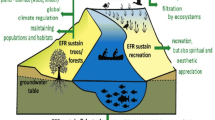Abstract
In recent years, many hydrology-based approaches have been used to assess the environmental flows in various river systems over the globe. However, their application has been very limited in India. Brahmani and Baitarani River basins in India are two important water surplus basins, in which several water resources projects are coming up shortly. There is an urgent need for the water planners and stakeholders to assess environmental flows at various locations of the river systems for best management practices of available water resources. The present paper (i) critically evaluates the applicability of existing approaches, (ii) provides values of environmental design flows at different locations of Brahmani and Baitarani River systems, and (iii)suggest a suitable scientific approach for the assessment of environmental flows.
Similar content being viewed by others
References
Agrawal, A. and Chak, A. (1991). Floods, Flood Plains and Environmental Myths. State of India’s Environment, A Citizen’s Report 3, New Delhi, Centre for Science and Environment, p. 167.
Arthington, A.H., Tharme, R.S., Brizga, S.O., Pusey, B.J., and Kennard, M.J. (2004). “Environmental flow assessment with emphasis on holistic methodologies.” Proceedings of the Second International Symposium on the Management of Large Rivers for Fisheries Volume II, RAP Publication 2004/17, FAO Regional Office for Asia and the Pacific, Bangkok, Thailand, pp. 37–65.
Brilly, M., Kobold, M., and Vidmar, A. (1997). “Water information management system and low flow analysis in Slovenia. FRIEND’97 — Regional Hydrology: concepts and models for sustainable water resource management.” Proceedings from the International Conference, Vol. 246, pp. 117–124.
Dakova, S., Uzunov, Y., and Mandadjiev, D. (2000). “Low flow — the river’s ecosystem limiting factor.” Ecological Engineering, Vol. 16, pp. 167–174.
Higgs, G. and Petts, G. (1988). Hydrological Changes and River Regulation in the UK, Regulated Rivers: Research & Management, Vol. 2, pp. 349–368.
King, J.M., Tharme, R.E., and Brown, C.A. (1999). Definition and Implementation of In-stream Flows. Thematic report for the World Commission on Dams, Southern Waters Ecological Research and Consulting: Cape Town, South Africa.
Michigan Department of Environmental Quality, Surface Water Quality Division (2002). Total Maximum Daily Load for Mercury for Hammell Creek, Houghton County, Michigan, Accessed: March 2004, http://www.deq.state.mi.us/documents/deq-wd-water-tmd/-hammellcreek.pdf, p. 7.
Naiman, R.J., Bunn, S.E., Nilsson, C., Petts, G.E., Pinay, G., and Thompson, L.C. (2002). “Legitimizing fluvial ecosystems as users of water: an overview.” Environmental Management, Vol. 30, pp. 455–467.
Petts, G.E. (1996). Water Allocation to Protect River Ecosystems, Regulated Rivers, Research and Management, Vol. 12, pp. 353–365.
Riggs, H.C., Caffey, J.E., Orsborn, J.F., Schaake, J.C., Singh, K.P., and Wallace, J.R. (Task Committee of Low-Flow Evaluation, Methods, and Needs of the Committee on Surface-Water Hydrology of the Hydraulics Division) (1980). “Characteristics of low flows.” Journal of the Hydraulics Division. Proceedings of the American Society of Civil Engineers, Vol. 106, pp. 717–731.
Sharma, K.N. (2005). “Unique ideas on water in ancient Indian scriptures and culture.” Proceedings of the IWRA XII World Water Congress. November 2005, New Delhi, Vol. 3, pp. 6.1–6.8.
Smakhtin, V.U. and Toulouse, M. (1998). Relationships between Low-flow Characteristics of South African streams, Water SA, 24: 107–112.
Smakhtin, V.U. (2001). “Low flow hydrology: a review.” Journal of Hydrology, Vol. 240, pp. 147–186.
Smakhtin, V.U., Shilpakar, R.L., and Hughes, D.A. (2006). “Hydrology based assessment of environmental flows: an example from Nepal.” Hydrological Sciences Journal, Vol. 51, No. 2, pp. 207–222
Stewardson, M.J., and Gippel, C.J. (2003). “Incorporating flow variability into environmental flow regimes using the flow events method.” River Research and Applications, Vol. 19, pp. 459–472.
Sugiyama, H., Vudhivanich, V., Whitaker, A.C., and Lorsirirat, K. (2003). “Stochastic flow duration curves for evaluation of flow regimes of rivers.” J. Am. Water Resources Assoc., Vol. 39, No. 1, pp. 47–58.
Tharme, R.E. (2003). “A global perspective on environmental flow assessment: emerging trends in the development and application of environmental flow methodologies for rivers.” River Research and Applications, Vol. 19, pp. 397–441.
Wallace, T.B. and Cox, W.E. (2002). Locating information on surface water availability in Virginia (draft). Accessed: March 2004, http://www.rappriverbasin.state.va.us/studies, p. 24.
Author information
Authors and Affiliations
Corresponding author
Rights and permissions
About this article
Cite this article
Jha, R., Sharma, K.D. & Singh, V.P. Critical appraisal of methods for the assessment of environmental flows and their application in two river systems of India. KSCE J Civ Eng 12, 213–219 (2008). https://doi.org/10.1007/s12205-008-0213-y
Received:
Accepted:
Published:
Issue Date:
DOI: https://doi.org/10.1007/s12205-008-0213-y




